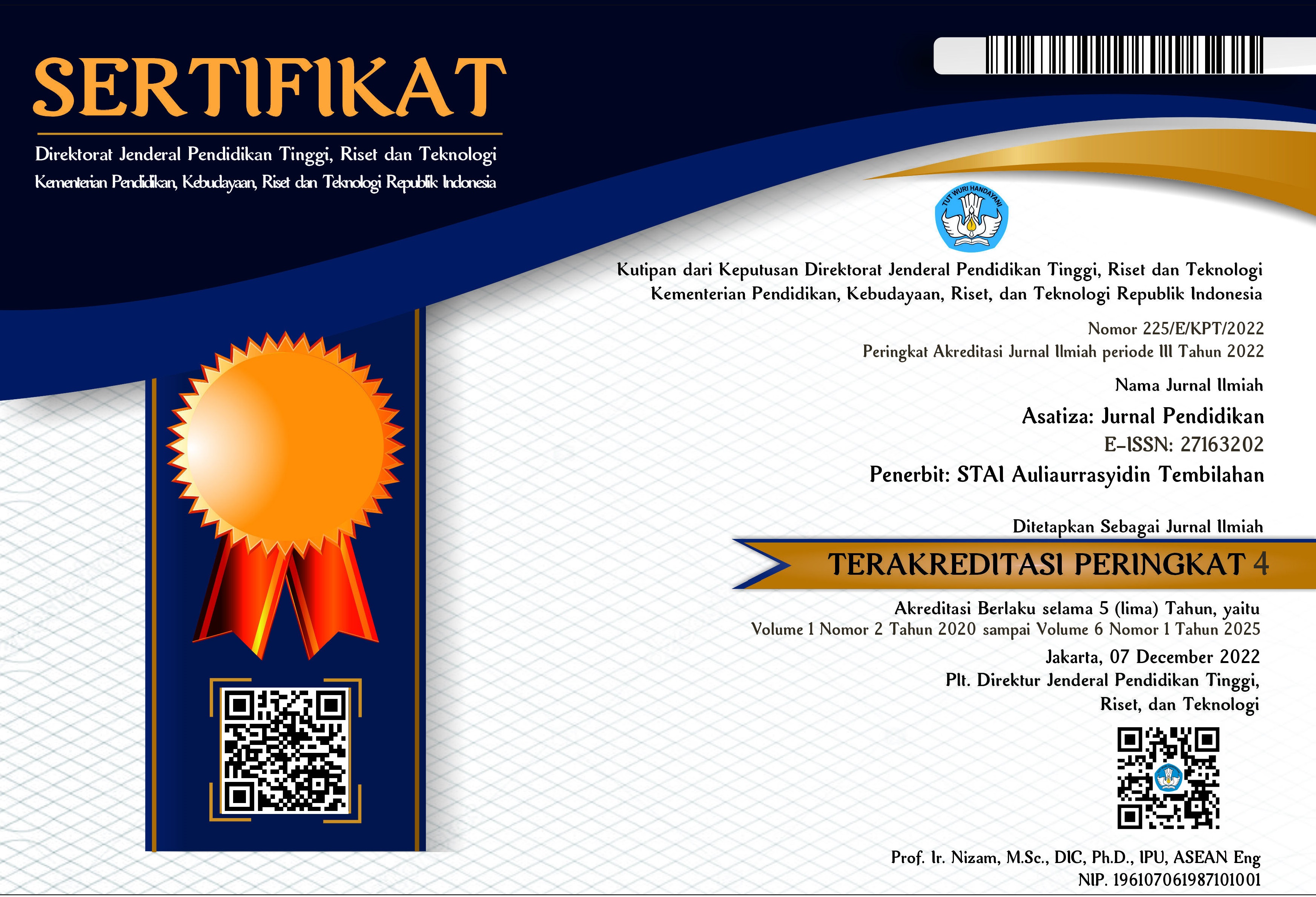Code-Switching in English as a Second Language (ESL) Classroom Settings: A Strategy or a Problem?
DOI:
https://doi.org/10.46963/asatiza.v4i3.859Keywords:
Code-switching, ESL, SLAAbstract
Code-switching, or switching from one language to another, is common in many bilingual and multilingual classrooms. Nonetheless, there have been opposing perspectives on its application in the classroom. While some studies argue that the presence of code-switching is beneficial to teaching language, others regard it as a hindrance to achieving the learning goal of acquiring the target language. This study addresses a research gap concerning teachers' and students' perspectives on code-switching in ESL classrooms, whether it is a strategy or a problem. This research method involves a systematic literature review process that is classified into three stages: planning, implementation, and reporting. Forty-five journal papers were discovered in the initial search string, and 34 were chosen based on inclusion and exclusion criteria for further research. The results of all research contained in journals published from 2012 to 2022 showed that there had been a debate with opposing perspectives over the usage of code-switching in classrooms. The majority of teachers and students perceive the practice of code-switching in ESL classrooms positively. However, many of them are aware of the potential negative consequences. Some individuals are even opposed to code-switching. Furthermore, the data suggested that code-switching might be a useful tool for teachers and students in ESL classrooms, depending on its purposes and functions. This study recommends that teachers use code-switching as needed by considering the purposes and consequences of its use.
Downloads
References
Albarillo, F. (2018). Information code-switching: A study of language references in academic libraries. College & Research Libraries, 79(5), 624.
Altun, M. (2021). Code-Switching in L2 Classrooms: A Useful Strategy to Reinforce Learning. Canadian Journal of Language and Literature Studies, 1(1), 21–26. https://doi.org/10.53103/cjlls.v1i1.13
Binmahboob, T. (2020). Code-Switching and Attitudes towards in EFL classes from English Teachers’ Perspective. Electronic Comprehensive Journal for Education and Science Publications, 32. www.mecsj.com
Braun, V. and Clarke, V. (2006), “Using thematic analysis in psychology”, Qualitative Research in Psychology, Vol. 3 No. 2, pp. 77-101.
Edvinsson, C. M. (2015). Teacher Code-Switching in Secondary ESL Classrooms in Sweden A Study of One Teacher’s Use of Code-Switching. LUP Student Papers, 1–29.
Elias, N. A., Norzaidi, A. I., Sabri, M. I. I. M., Singh, C. K. S., Uma, Ramanlingam, S., & Maniam, M. (2022). ESL Learners’ Perceptions of Code-Switching in the English Language Classroom. International Journal of Asian Social Science, 12(5), 158–168. https://doi.org/10.55493/5007.v12i5.4494
Fachriyah, E. (2017). The functions of code switching in an English language classroom. Studies in English Language and Education, 4(2), 148–156. https://doi.org/10.24815/siele.v4i2.6327
Fareed, M., Humayun, S., & Akhtar, H. (2016). English Language Teachers’ Code-switching in Class: ESL Learners’ Perceptions. Journal of Education & Social Sciences, 4(1). https://doi.org/10.20547/jess0411604101
Fe Enriquez, C., Candido, G., Abing, N. F., Bucog, F., & Bacatan, J. (2022). Code switching in Grade 11 students of UM Peñaplata College Article Info. Journal of English Language Teaching, 11(3), 201–216. http://journal.unnes.ac.id/sju/index.php/elt
Gulzar, M. S. (2014). Teachers’ Code-Switching in a Content-Focused English as a Second Language (ESL) Classroom: Patterns and Functions. International Journal of Linguistics, 6(4), 130. https://doi.org/10.5296/ijl.v6i4.6162
Hidayati, S. (2016). How should teachers view learner code switching in second/ foreign language classrooms? Eternal (English Teaching Journal), 7(2), 83–97.
Jumal, N. A. B., Al Saqqaf, A., & Mohamed, N. Z. N. (2019). Code Switching in Malaysian Secondary ESL Classroom: A Preliminary Study from Sabah. International Journal of Asian Social Science, 9(5), 327–334. https://doi.org/10.18488/journal.1.2019.95.327.334
Junaidi, A. M. (2019). The communicative function and the benefit of code switching within bilingual education program or multilingual children in learning English. Journal Ilmiah Rinjani_Universitas Gunung Rinjani, 7(2), 59–66.
Khan, K. S., Kunz, R., Kleijnen, J., & Antes, G. (2003). Five steps to conducting a systematic review. JRSM, 96(3), 118–121. https://doi.org/10.1258/jrsm.96.3.118
Mackey, W. F. (1972). The Description of Bilingualism. In J. A. Fishman (Ed.), Fishman, J.A. Ed., 1972. Readings in The Sociology of Language. The Hague-Paris: Mouton.
Makulloluwa, E. (2013). Code switching by teachers in the second language classroom. International Journal of Arts & Sciences, 6(3), 581–598.
Mareva, R. (2016). Learners’ code-switching in English as a Second Language (ESL) lessons: perspectives of four secondary school teachers in Zimbabwe. IRA International Journal of Education and Multidisciplinary Studies (ISSN 2455–2526), 4(1). https://doi.org/10.21013/jems.v4.n1.p10
Memon, N., Altaf, S., & Khuwaja, N. A. (2016). The Functions of Code Switching in ESL Classrooms of Sindh University. International Research Journal of Arts & Humanities (IRJAH), 44(44), 101–106.
Memory, N. D., Nkengbeza, D., & Liswaniso, C. M. (2018). The effects of code switching on English language teaching and learning at two schools in Sibbinda circuit. International Journal of English Language Teaching, 6(5), 56–68. www.eajournals.org
Modupeola, O. R. (2013). Code-Switching as a teaching strategy: Implication for English Language teaching and learning in a multilingual society. IOSR Journal of Humanities and Social Science (IOSR-JHSS, 14(3), 92–94. www.Iosrjournals.Org
Muthusamy, P., Muniandy, R., Kandasamy, S. S., Hussin, O. H., Subramaniam, M., & Farashaiyan, A. (2020). Factors of code-switching among bilingual international students in Malaysia. International Journal of Higher Education, 9(4), 332–338. https://doi.org/10.5430/ijhe.v9n4p332
Narayan, R. (2019). Code-switching as a linguistic resource in the fijian ESL classrooms: Bane or boon? Journal of Language Teaching and Research, 10(3), 427–436. https://doi.org/10.17507/jltr.1003.04
Nasrullah, Rosalina, E., & Elyani, P. E. (2020). Utilizing learner language to craft well-targeted endorsements in English language teaching practices. English Language Teaching Educational Journal, 3(3), 254–262. https://doi.org/10.12928/eltej.v3i3.2277
Nordin, N. M., Ali, F. D. R., Zubir, S. I. S. S., & Sadjirin, R. (2013). ESL Learners Reactions Towards Code Switching in Classroom Settings. Procedia - Social and Behavioral Sciences, 90, 478–487. https://doi.org/10.1016/j.sbspro.2013.07.117
Nurhamidah. (2018). Code-Switching: To what extent it benefits in EFL classroom? Language and Literature International Conference (ELLiC), 2, 69–75.
Pontillas, M., Agna, A., Molina, C., & Ignacio, J. (2022). Exploring Codeswitching Occurrences in an Online English Language Learning in a State College, Philippines. Journal of Education, Management and Development Studies, 2(3), 37–46. https://doi.org/10.52631/jemds.v2i3.123
Simasiku, L. (2016). The Impact of Code Switching on Learners’ Participation during Classroom Practice. Studies in English Language Teaching, 4(2), 157–167. www.scholink.org/ojs/index.php/selt
Tabassum, F., Rafique, H., Akram, N., & Khan, M. A. (2020). Functions of Code Switching in the English Language Teaching Classroom Discourse: Perspectives of Lecturers and Students Farhana Tabassum (Corresponding Author) Hina Rafique. International Journal of English Language and Linguistics Research, 8(2), 47–65.
Triandini, E., Jayanatha, S., Indrawan, A., Werla Putra, G., & Iswara, B. (2019). Metode Systematic Literature Review untuk Identifikasi Platform dan Metode Pengembangan Sistem Informasi di Indonesia. Indonesian Journal of Information Systems, 1(2), 63. https://doi.org/10.24002/ijis.v1i2.1916
Younas, M., Afzaal, M., Noor, U., Khalid, S., & Naqvi, S. (2020). Code Switching in ESL Teaching at University Level in Pakistan. English Language Teaching, 13(8), 63. https://doi.org/10.5539/elt.v13n8p63
Zanoni, F. (2016). Code-switching in CLIL classes: a Case Study. EL. LE, 5(2), 279–296. https://doi.org/10.14277/2280-6792/ELLE-5-2-6
Downloads
Published
Issue
Section
License
Copyright (c) 2023 Nur Anisah, Nasrullah Nasrullah

This work is licensed under a Creative Commons Attribution-ShareAlike 4.0 International License.
Authors who publish with this journal agree to the following terms:
1. Copyright on any article is retained by the author(s).
2. The author grants the journal, right of first publication with the work simultaneously licensed under a Creative Commons Attribution shareAlike 4.0 International License that allows others to share the work with an acknowledgment of the work’s authorship and initial publication in this journal.
3. Authors are able to enter into separate, additional contractual arrangements for the non-exclusive distribution of the journal’s published version of the work (e.g., post it to an institutional repository or publish it in a book), with an acknowledgment of its initial publication in this journal.
4. Authors are permitted and encouraged to post their work online (e.g., in institutional repositories or on their website) prior to and during the submission process, as it can lead to productive exchanges, as well as earlier and greater citation of published work.
5. The article and any associated published material is distributed under the Creative Commons Attribution-ShareAlike 4.0 International License











2.png)



